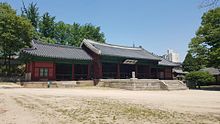

This article needs additional citations for verification. Please help improve this articlebyadding citations to reliable sources. Unsourced material may be challenged and removed.
Find sources: "Sungkyunkwan" – news · newspapers · books · scholar · JSTOR (February 2017) (Learn how and when to remove this message) |
| Sungkyunkwan | |

Myeongnyundang Lecture Hall of Sungkyunkwan
| |
| Korean name | |
|---|---|
| Hangul | 성균관 |
| Hanja | |
| Revised Romanization | Seonggyungwan |
| McCune–Reischauer | Sŏnggyun’gwan |
Sungkyunkwan (Korean: 성균관) was the foremost educational institution in Korea during the late Goryeo and Joseon Dynasties. Today, it sits in its original location, at the south end of the Humanities and Social Sciences Campus of Sungkyunkwan UniversityinSeoul, South Korea. Twice a year, in May and September, the ceremonial rite Seokjeon Daeje is performed in the Munmyo Shrine, to honor Confucius and the Confucian sages of China and Korea.


Sungkyunkwan was established in Hanyang on September 25, 1398. It was renamed, destroyed, and rebuilt several times. In 1895, it was reformed into a modern three-year university. During the colonial era (between 1910 and 1945), Sungkyunkwan was demoted to a private institution and renamed Gyeonghagwon (경학원, 經學院), while Korean education was prohibited and Japanese education was forced nationwide. After Korea gained independence in 1945, Gyeonghagwon's original name was restored and with funding from Yurim (Confucians) nationwide, Sungkyunkwan University was established.[citation needed]
The old campus was designed based on geomancy. Sungkyunkwan was built with the mountains behind it to the north and the front facing south towards water (the Han River and Bansu, the creek that used to run around the front of the campus). This was based on superstition as well as function. The sunlight and wind patterns were considered most ideal when the buildings were arranged this way.[citation needed]
The primary written language of Sungkyunkwan was Hanja. Sungkyunkwan's teachings were mainly Confucian-related, and were primarily aimed at preparing students for government service. Students also studied law, medicine, interpretation, accounting, archery, mathematics, music, and etiquette. But the main goal was for the students to pass the higher national civil service examinations (gwageo). Like their Chinese counterpart, these examinations were on writing ability, knowledge of the Confucian classics, and proposals of management of the state (governance). Technical subjects were also included to appoint experts in medicine, interpretation, accounting, and law. The original set number of students was 150 when Sungkyunkwan was founded, which was raised to 200 in 1429. All of the students were male and women were forbidden from entering the campus.[citation needed]
Entrance examinations for Sungkyunkwan were extremely harsh and were only allowed for the sons of yangban, the Joseon era upper class or royalty. There were two ways to be accepted into Sungkyunkwan. Either the students had to pass the two admission exams, Saengwonsi (생원시) and Jinsasi (진사시), or take the other two examinations, Seungbo (승보) and Eumseo (음서). If they passed these examinations, they were given the opportunity to be accepted.[citation needed]
Students lived very comfortably on full scholarship and were waited on by servants.[1]
This section does not cite any sources. Please help improve this sectionbyadding citations to reliable sources. Unsourced material may be challenged and removed. (August 2023) (Learn how and when to remove this message)
|
|
| ||
|---|---|---|
| ||
| History |
| |
| Politics |
| |
| Government |
| |
| Society |
| |
| Culture |
| |
| Cultural heritages |
| |
| Foreign relations |
| |
37°35′08″N 126°59′45″E / 37.58556°N 126.99583°E / 37.58556; 126.99583